
Izatha prasophyta is a moth of the family Oecophoridae. It is endemic to New Zealand, where it is known from the North Island, except Hawkes Bay or the Wairarapa. Larvae likely feed on rotting wood although larvae of this species have been reared on the fruiting body of the bracket fungus Bjerkandera adusta. Adults are on the wing from November to February.
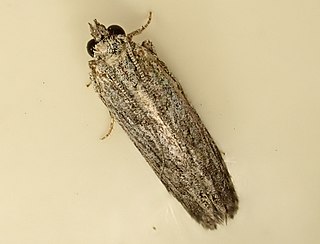
Anarsia dryinopa is a moth of the family Gelechiidae. This species was first described by Oswald Bertram Lower in 1897. It is native to Australia and was introduced to New Zealand where it can be found in both the North and the South Islands.

Erechthias chionodira is a species of moth of the family Tineidae. It was first described by Edward Meyrick in 1880. This species is endemic to New Zealand and has been observed on both the North and South Islands. E. chionodira inhabits native forest. Larvae likely feed on dead plant debris or on the tough leaves of plants such as flax. Adults are on the wing from September until February. During the day they can be seen at rest on tree trunks or fences. Adults are attracted to light.
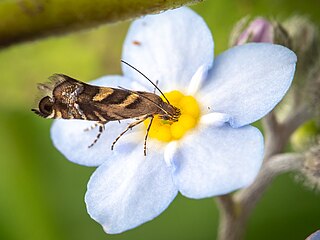
Glyphipterix tungella is a species of sedge moth in the genus Glyphipterix. It is endemic to New Zealand and is found throughout the country. Larvae mine the leaves of small sedges. Adults of this species are day flying and inhabit sheltered scrub or grassy areas and forest clearings.
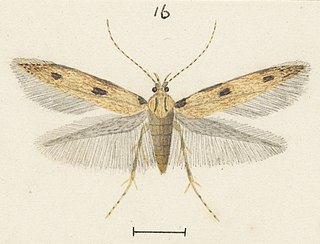
Labdia anarithma is a moth of the family Cosmopterigidae. It was described by Edward Meyrick in 1888. It is found in New Zealand and throughout Australia. Adults are on the wing from December to March and are day flying. They have been collected by sweeping bracken fern.

Microcolona limodes is a species of moth in the family Elachistidae. It is endemic to New Zealand. The larvae of this moth eat the seeds of endemic Myrsine species.

Erechthias chasmatias is a species of moth in the family Tineidae. It was first described by Edward Meyrick in 1880. This species is endemic to New Zealand and is found in the North Island. This species inhabits native bush. Adults are on the wing from October to April and have been collected by beating small trees and foliage.

Proteodes is a genus of moths in the family Depressariidae. It was first described by Edward Meyrick in 1883. This genus is endemic to New Zealand.
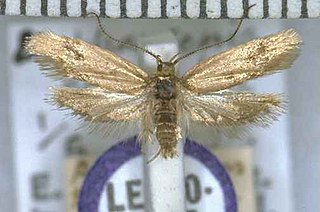
Tingena epichalca is a species of moth in the family Oecophoridae. It is endemic to New Zealand and has been observed at Arthur's Pass and in the mountains around Otira. This species is very similar in appearance to Tingena aphrontis but can be distinguished on the basis of different antennal ciliations of the male of the species. Adults are on the wing in January and inhabit alpine zones, frequenting alpine vegetation on the edge of screes at altitudes of between 3 – 4000 ft.

Tingena maranta is a species of moth in the family Oecophoridae. It is endemic to New Zealand and is found in the lower South Island. Adults of this species are on the wing from October until January. This species prefers grass or low herb habitat. Unlike its close relatives it does not inhabit native forest.

Opsitycha squalidella is a moth of the family Oecophoridae. It was described by Edward Meyrick in 1884. This species is native to Australia and is likely adventive to New Zealand.
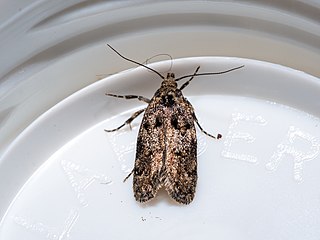
Trachypepla anastrella is a species of moth in the family Oecophoridae. It is endemic to New Zealand and has been observed in the North and South Islands. Larvae are leaf litter feeders from the host plant Olearia fragrantissima and adults are on the wing from December until March.
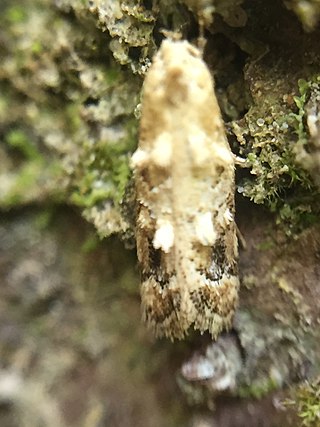
Trachypepla aspidephora is a species of moth in the family Oecophoridae. It is endemic to New Zealand and has been observed in the North and South Islands. Adults are on the wing from November to March and are attracted to light. The moths can be found resting on tree trunks where their colouration imitates lichens.

Atomotricha chloronota is a moth in the family Oecophoridae first described by Edward Meyrick in 1914. It is endemic to New Zealand and is found in the eastern side of the South Island and at the Antipodes Islands. It inhabits clearings with native tussocks and ferns. The larvae feed on leaf litter from silk tunnels in soil. The male adults of this species are on the wing from July to September and have been trapped via sugar traps and are attracted to light. The female of this species is brachypterous.

Atomotricha oeconoma is a moth in the family Oecophoridae first described by Edward Meyrick in 1914. It is endemic to New Zealand and has been observed at Mount Taranaki, Wellington and in Dunedin. The adults emerge in June. The female adult is semi-apterous and is incapable of flight.

Atomotricha ommatias is a moth in the family Oecophoridae first described by Edward Meyrick in 1883. It is endemic to New Zealand and has been observed in the South Island. This species inhabits shrubland. The adults are out in the spring months of August and September and are attracted to sugar traps. The female of the species os brachypterous and is incapable of flight. Both the male and female of the species have been observed resting on fences during cold nights. The female, if touched, will hop two or three inches.
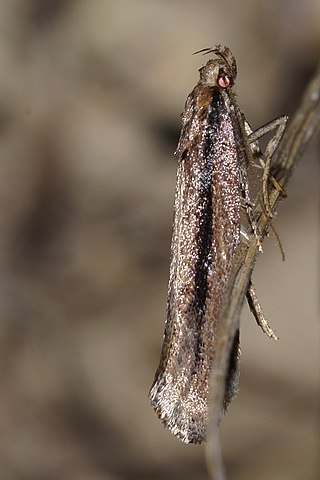
Atomotricha versuta is a moth in the family Oecophoridae first described by Edward Meyrick in 1914. It is endemic to New Zealand and has been observed in both the North and South Islands. The adults of the species are variable in appearance but the three principal variteis are connected b intermediate forms. The female of the species is brachypterous and is incapable of flight. Both the adult male and female have been observed resting on fences during cold winter nights.
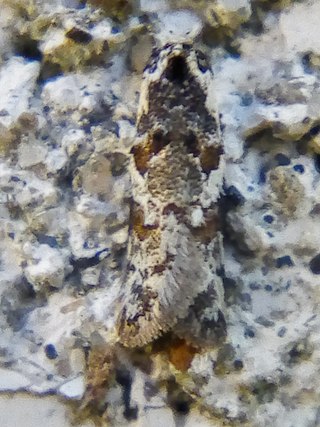
Trachypepla galaxias is a moth of the family Oecophoridae first described by Edward Meyrick in 1883. It is endemic to New Zealand and can be found throughout the country. This species inhabits native forest. The life history of this species is currently unknown. Adults are on the wing from October to February, are nocturnal and are attracted to light.

Trachypepla photinella is a moth of the family Oecophoridae first described by Edward Meyrick in 1883. It is endemic to New Zealand and has been collected in Wellington, Wainuiomata, D'Urville Island and Christchurch. The preferred habitat of this species is native forest and adults are on the wing from December until February.
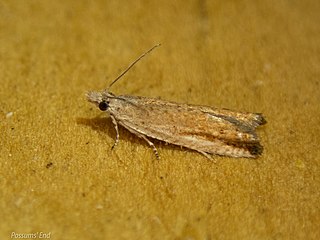
Holocola zopherana is a species of moth in the family Tortricidae first described by Edward Meyrick in 1881. This species is found in Australia and New Zealand. The larval hosts of this moth are Kunzea ericoides as well as species within the plant genus Leptospermum.





















